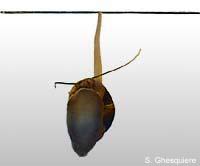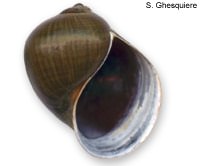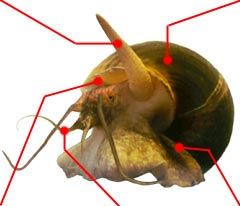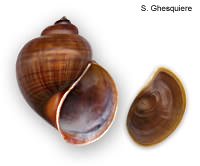|
Do you have an apple snail?
|
It's not difficult to recognise an apple
snail if you know where to look for.
In order to find out if you have an apple snail or not, the most visible features
are listed below.
There are also less apparent anatomical characteristic like the lung-gill
combination and the anatomy of the radula.
 |
|
 |
|
| The eggs of most apple snails
are laid above the water level. If your snail laid her eggs above the water, you can be sure it's an apple snail. If not it can still be an apple snail (some apple snails do lay their eggs in the water). |
 |
The shell opening (aperture) of the apple snails increases quickly with every whorl. This gives them a globose (round) shell shape. | |
 |
|
 |
|
|
Apple snails can be confused with snails from the Viviparidae
family. The snails from this family look very similar in shape and colour, but
they do lack a lung, a siphon (obvious)
and labial tentacles (the small tentacles near the mouth).
In contrast with the egg-laying Ampullariidae snails, the Viviparidae
snails are live bearing (hence the name Viviparidae, which can be translated
as live bearing).
If you want some basic information about other freshwater snails, read the 'other-snails-section'.
Once you have recognised the snail as an apple snail, you probably want to know
which kind of species it belongs to. For this
purpose there is a 'quick and dirty' identification guide on
this site.
Note that this only applies for pet-shop derived apple snails, for other sources of
snails, things can get *much* more complicated as there are many apple snail species, some
of which are very difficult to determine on external features only. Some species can only
be discriminated on internal anatomy (in particular the sex
organs).
|
Except where otherwise noted, this page is licensed under a Creative Commons Attribution-NonCommercial-ShareAlike 2.5 License . http://www.applesnail.net |
|